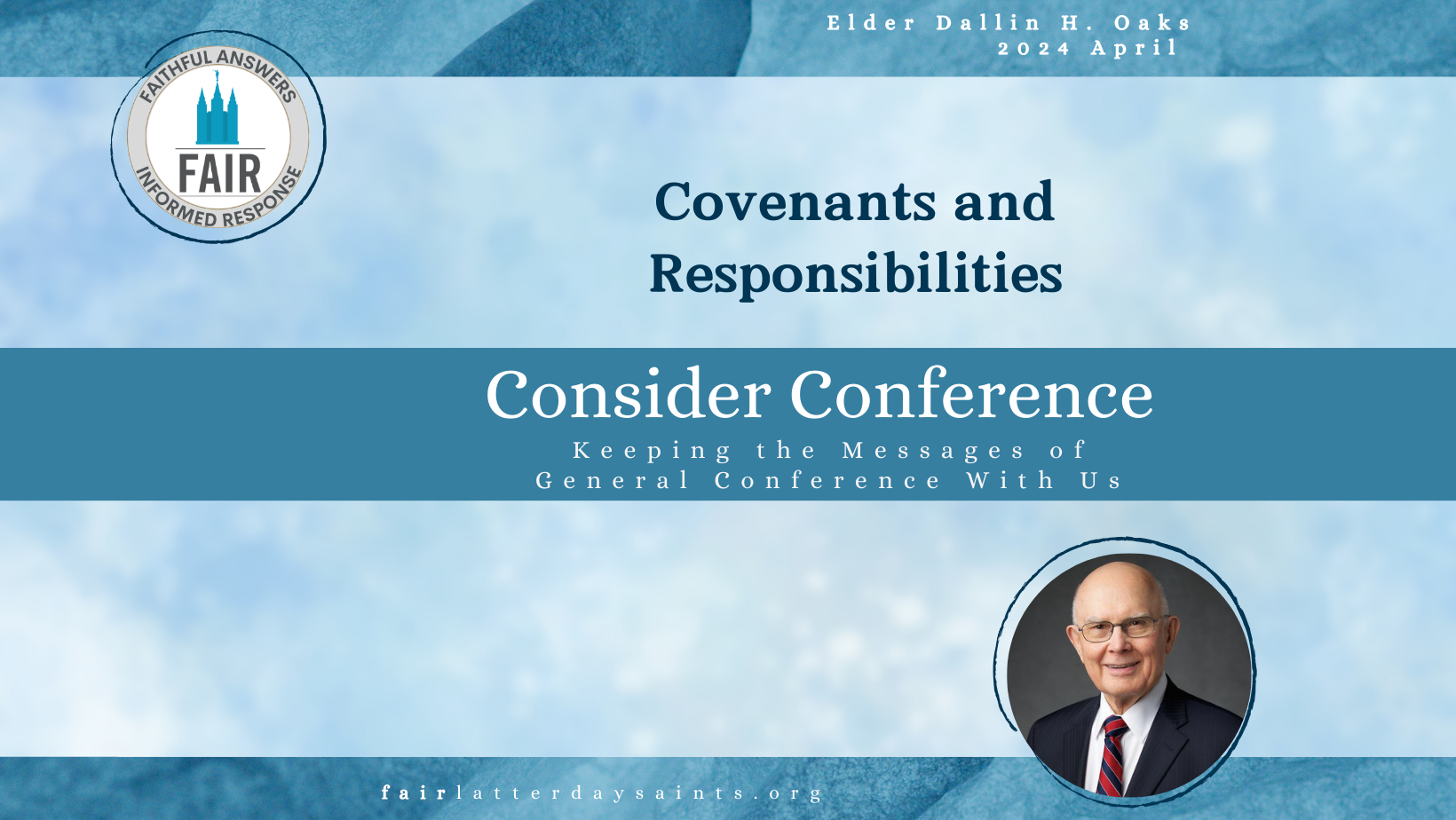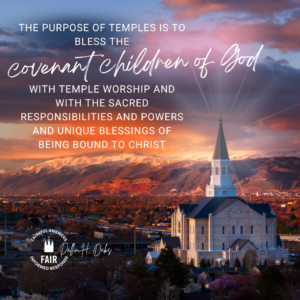
2024 April General Conference, Sunday Morning Session
Covenants and Responsibilities
Elder Dallin H. Oaks
First Counselor in the First Presidency
Summary
- The Church of Jesus Christ is known as a church that emphasizes making covenants with God.
- In his talk “Covenants and Responsibilities,” President Dallin H. Oaks emphasizes the foundational role of covenants in The Church of Jesus Christ of Latter-day Saints and their significance in both personal and societal commitments. He explains that covenants, formal commitments to fulfill specific responsibilities, are essential for personal regulation and societal functioning. Highlighting examples from various professions and religious traditions, he underscores the importance of covenants in the restored gospel of Jesus Christ, particularly through ordinances like baptism and temple ceremonies. Temples and the associated covenants are central to the Church’s mission, providing unique blessings and binding members to Christ, ultimately guiding them toward eternal life.
Gospel Doctrine & Principles taught
The Plan of Salvation, The Restoration, Ordinances and Covenants, The Covenant Path
Scriptures
Genesis 17:2–9; Exodus 6:2–4; 19:5–6; Leviticus 26:42; see also 2 Nephi 9:1; 1 Nephi 13:23, 1 Nephi 15:18; 17:40; 22:9; 2 Nephi 29:14, 1 Nephi 14:14; 2 Nephi 6:13; 9:1, 2 Nephi 1:5; 3:4; 31:7, 13, 14; Mosiah 5:5–8; 6:1; Alma 7:15; 46:21–22, Joseph Smith—History 1:33–34, 39, Hebrews 8:8, Hebrews 12:24. Doctrine and Covenants 76:69, Doctrine and Covenants 115:4, Doctrine and Covenants 20:37; see also Mosiah 18:10–13, Doctrine and Covenants 20:75, 77; Doctrine and Covenants 1:15, Doctrine and Covenants 1:22, 2 Nephi 4:32; 33:9, Doctrine and Covenants 76:59, 62, Doctrine and Covenants 14:7
Other Sources
Church History Topics, “Nauvoo Temple”
Related talks:
- Gordon B. Hinckley, “God Is at the Helm”
- Russell M. Nelson, “As We Go Forward Together”
- Russell M. Nelson, “The Everlasting Covenant”
Look for Jesus Christ:
- Testimony of Christ.
- I testify of Jesus Christ, who is the head of that Church, and invoke His blessings on all who seek to keep their sacred covenants.
- Description of His Atonement.
- Jesus (is) the mediator of the new covenant, who wrought out this perfect atonement through the shedding of his own blood.
- Description of His relationship with us.
- The Abrahamic covenant is fundamental to several great religious traditions. It introduces the holy idea of God’s covenant promises with His children.
- People who enter into covenants with God are called “the covenant people of the Lord.”
- The Mediator of the New Covenant
- Words of Christ.
- Behold, the days come, saith the Lord, when I will make a new covenant with the house of Israel and with the house of Judah
- And the arm of the Lord shall be revealed; and the day cometh that they who will not hear the voice of the Lord, neither the voice of his servants, neither give heed to the words of the prophets and apostles, shall be cut off from among the people; For they have strayed from mine ordinances, and have broken mine everlasting covenant;
- But that every man might speak in the name of God the Lord, even the Savior of the world; that faith also might increase in the earth; that mine everlasting covenant might be established;
- And, if you keep my commandments and endure to the end you shall have eternal life, which gift is the greatest of all the gifts of God.
Inspiring Words & Phrases
- …We know from millennia of experience that persons give up some individual freedoms to gain the advantages of living in organized communities. Such relinquishments of individual freedoms are principally based on commitments or covenants, expressed or implied.
- The Abrahamic covenant is fundamental to several great religious traditions. It introduces the holy idea of God’s covenant promises with His children.
- We do not know the full content of the angel Moroni’s early instructions to this maturing young prophet. We do know he told Joseph that “God had a work for [him] to do” and that “the fulness of the everlasting Gospel” must be brought forth, including “the promises made to the fathers.” We also know that the scriptures young Joseph read most intensively—even before he was directed to organize a church—were the many teachings about covenants he was translating in the Book of Mormon. That book is the Restoration’s major source for the fullness of the gospel, including God’s plan for His children, and the Book of Mormon is filled with references to covenants.
- Covenants were foundational in the Restoration of the gospel.
- The central role of covenants in the newly restored Church was reaffirmed in the preface the Lord gave for the first publication of His revelations.
- President Gordon B. Hinckley gave this summary of the effect of our baptism and our weekly partaking of the sacrament: “Every member of this church who has entered the waters of baptism has become a party to a sacred covenant. Each time we partake of the sacrament of the Lord’s supper, we renew that covenant.”
- President Russell M. Nelson often refers to the plan of salvation as the “covenant path” that “leads us back to [God]” and “is all about our relationship with God.” He teaches about the significance of covenants in our temple ceremonies and urges us to see the end from the beginning and to “think celestial.”
- Now I speak more of temple covenants…There (in the temple) persons who were endowed were to be taught God’s plan of salvation and invited to make sacred covenants. Those who lived faithful to those covenants were promised eternal life, wherein “all things are theirs” and they “shall dwell in the presence of God and his Christ forever and ever.”
- persons who wear their garments faithfully and keep their temple covenants continually affirm their role as disciples of the Lord Jesus Christ.
 The Church of Jesus Christ of Latter-day Saints is constructing temples all over the world. Their purpose is to bless the covenant children of God with temple worship and with the sacred responsibilities and powers and unique blessings of being bound to Christ they receive by covenant.
The Church of Jesus Christ of Latter-day Saints is constructing temples all over the world. Their purpose is to bless the covenant children of God with temple worship and with the sacred responsibilities and powers and unique blessings of being bound to Christ they receive by covenant.- Covenants are inherent in each of the ordinances of salvation and exaltation this restored Church administers.
- The ordinance of baptism and its associated covenants are requirements for entrance into the celestial kingdom. The ordinances and associated covenants of the temple are requirements for exaltation in the celestial kingdom, which is eternal life, “the greatest of all the gifts of God.” That is the focus of The Church of Jesus Christ of Latter-day Saints.
Lists
Here are some examples of covenant responsibilities in our society:
- Judges
- Military
- Medical personnel
- Firefighters
- LDS full time missionaries
All of those involved in these familiar occupations make a commitment—often formalized by oath or covenant—to perform their assigned duties.
Those under such covenant can be identified by distinctive clothing, name tags, and wedding rings which are intended to:
- Signify that the wearer is under covenant
- Signify that the wearer has a duty to teach and serve
- Signify that the wearer should be supported in their service
- To remind the wearers of their covenant responsibilities.
There is no magic in their distinctive clothing or symbols, only a needed reminder of the special responsibilities the wearers have assumed.
Covenants are:
- a foundation for the regulation of individual lives
- a commitment to fulfill certain responsibilities
- the foundation and history of many religious affiliations
The practice of covenanting with God or religious leaders is recorded:
- In the Old Testament (the Abrahamic covenant)
- In the Book of Mormon writings about Nephi
- In the Book of Mormon writings about Joseph in Egypt
- In the Book of Mormon writings about King Benjamin
- In the Book of Mormon writings about Alma
- In the Book of Mormon writings about Captain Moroni
The Book of Mormon is:
- The Restoration’s major source for the fullness of the gospel
- The major source for information about God’s plan for His children
- Filled with references to covenants
Some covenants in the restoration are:
- Baptism
- Partaking of the Sacrament
- The endowment
About the temple garment:
- Persons who have been endowed in a temple are responsible to wear a temple garment
- The garment is an article of clothing not visible because it is worn beneath outer clothing.
- The garment reminds endowed members of the sacred covenants they have made in the holy temple
- The garment reminds endowed members of the blessings they have been promised in the holy temple.
- We are instructed to wear temple garments continuously (with obviously necessary exceptions)
- To remove one’s garments can be understood as a disclaimer of the covenant responsibilities and blessings to which they relate
- persons who wear their garments faithfully and keep their temple covenants continually affirm their role as disciples of the Lord Jesus Christ.
Definitions
- covenant = a commitment to fulfill certain responsibilities
- The New Testament = The New Covenant
Warnings
- Personal commitments are essential to the regulation of our individual lives and to the functioning of society. This idea is currently being challenged. A vocal minority oppose institutional authority and insist that persons should be free from any restrictions that limit their individual freedom.
- Because covenants do not “take a day off,” to remove one’s garments can be understood as a disclaimer of the covenant responsibilities and blessings to which they relate.
Blessings/Promises
- Persons who wear their garments faithfully and keep their temple covenants continually affirm their role as disciples of the Lord Jesus Christ.
- I testify of Jesus Christ, who is the head of that Church, and invoke His blessings on all who seek to keep their sacred covenants.
Stories:
- When I was born in Utah in 1932, our Church membership was only about 700,000, clustered mostly in Utah and nearby states. At that time, we had only 7 temples. Today the membership of The Church of Jesus Christ of Latter-day Saints numbers more than 17 million in about 170 nations. As of this April 1, we have 189 dedicated temples in many nations and 146 more in planning and construction.
- The endowment ceremonies in the Nauvoo Temple provided early pioneers with spiritual strength and power, which they testified helped them endure their difficult journey and successfully establish themselves in the West.
Application Ideas
- President Oaks mentions several examples of covenant responsibilities in our society. Take the time to examine the covenants these professionals enter into: The Air Force Oath of Enlistment, The U.S. Army Oath of Enlistment, the Oaths of justices and judges, the Firefighter Code of Ethics, and the Oath of Modern Hippocrates. What do these oaths (covenants) have in common?
- Examine the list above: “About the Temple Garment.” As you ponder this list, consider the different oaths of military, firefighters, doctors and judges. What difference does it make that these professionals wear clothing that identifies them? Do any of those reasons apply to the wearing of the temple garment?
- Consider watching or listening to “We Need an Endowment,” by Anthony Sweat.
- As he concludes his talk, President Oaks invokes God’s blessings on “all who seek to keep their sacred covenants.” Make it a matter of prayer to know how to keep your covenants in a way that pleases God. Write any impressions you have in your journal.
